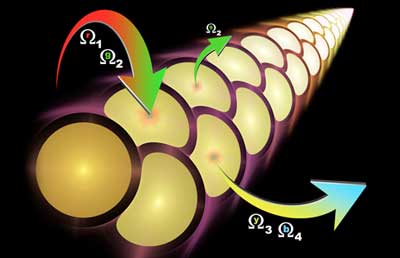| Posted: Nov 20, 2017 |
Developing 'ABCs' for exploiting new phenomena in light-matter interactions
(Nanowerk News) A unique class of engineered light-manipulating materials, known as metamaterials or structured materials, makes use of patterns of strongly interacting wavelength or sub-wavelength-sized elements. Because of these intricate internal and surface structures, new properties have emerged, some exhibiting behavior that has resulted in rewriting long-understood “laws” for how light and other electromagnetic (EM) waves interact with materials. These materials have been opening up new options for controlling EM waves in many technological arenas, among them imaging, thermal control, and frequency conversion. Specific applications include night-vision, heat reflection and management in aircraft engines, and temperature regulation of electronics on satellites in the hot-and-cold extremes of space.
|
 |
| DARPA's Nascent Light-Matter Interactions (NLM) program aims to develop theory-anchored models that could yield new structures for materials with never-before-seen electromagnetic properties. This artist's concept depicts an example of how an engineered material might be able to convert, generate, or harvest electromagnetic fields exploiting interactions that could have far-reaching effects in areas such as sensing, thermal control, frequency conversion, and dynamics.
|
|
Although researchers have been taking steps toward putting these materials to practical use, they remain puzzled about the optimal structure designs for desired matter-light interactions. They have yet to model the materials in ways that enable predictions about how specific structured materials will behave under different conditions, such as increased illumination intensities. To fill in these knowledge gaps, DARPA today announced the Nascent Light-Matter Interactions (NLM) program, which seeks to finally develop theory-anchored models that can expand the state of the art in already-observed phenomena while pointing to never-before-realized and new functionality.
|
|
“Recent advances in our understanding of light-matter interactions have revealed nascent concepts that could yield new materials with properties way beyond anything we have now,” said Mike Fiddy, DARPA program manager. “Through NLM we aim to identify building blocks to better understand the physics of 2-D and 3-D structured materials, which can then lead to a systematic design approach for controlling electromagnetic waves through these materials. The end goal is to equip designers with rigorous predictive models and design tools to answer the currently elusive question: ‘If I want a material with X property, how do I build it?’”
|
|
For example, can we open new pathways for designing materials that provide more efficiency in up-conversion or down conversion of frequencies, which could benefit military capabilities such as night vision? “At the moment, the state-of-the-art of these complicated structures is you pump them with one frequency and they’ll emit maybe 10 percent at another frequency, but they require lots of power in the process,” he said. “Can we develop design tools to create materials with 80, 90, or 100 percent efficiency in converting infrared light into visible light that require very little or no power?”
|
|
As Fiddy sees it, lessons learned in the NLM program also might help engineers design better materials, for example, that automatically block the frequency of a laser if it’s shined directly into the eye. Another example is managing extremely hot temperatures, such as those found in turbine aircraft engines. New engineered materials could help precisely manage temperatures in critical hot parts of the engine, which in turn could lead to more efficiency, thus reducing fuel and maintenance costs.
|
|
“Similarly, on satellites, as they orient toward the sun they can get ‘cooked’ and when they are out of the sun they are very cold,” Fiddy said. “Those big temperature extremes have to be controlled somehow in the satellite’s design. But if there were more efficient ways of radiating away the sun’s heat using structured materials, that would be very valuable. A general approach to solving this problem could be beneficial for keeping computer chips cool while at the same time opening up new ways to harvest electromagnetic energy.”
|
|
It could take years to realize such possibilities, Fiddy noted, but he hopes the NLM program will deliver new levels of understanding and modeling tools that could hasten that day. As such, he added, this new program should benefit existing programs, such as EXTREME, which focuses on specific uses for engineered materials.
|
|
The NLM program will unfold in three phases. The first will challenge performers to develop a model and show that it can predict new phenomena and serve as a design tool. The second phase will push researchers to test the models’ actual utility for identifying new materials useful for specific applications. The goal for Phase 3 is to identify specific challenge problems and tie selected performers and their respective focus and applications to the operational needs of DoD stakeholders.
|
|
DARPA announced a webcast Proposers Day for potential NLM proposers on Nov. 28, 2017. A Special Notice with registration information and other details is available here: https://go.usa.gov/xnWut. A Broad Agency Announcement (BAA) solicitation will be posted on FBO in the near future.
|

